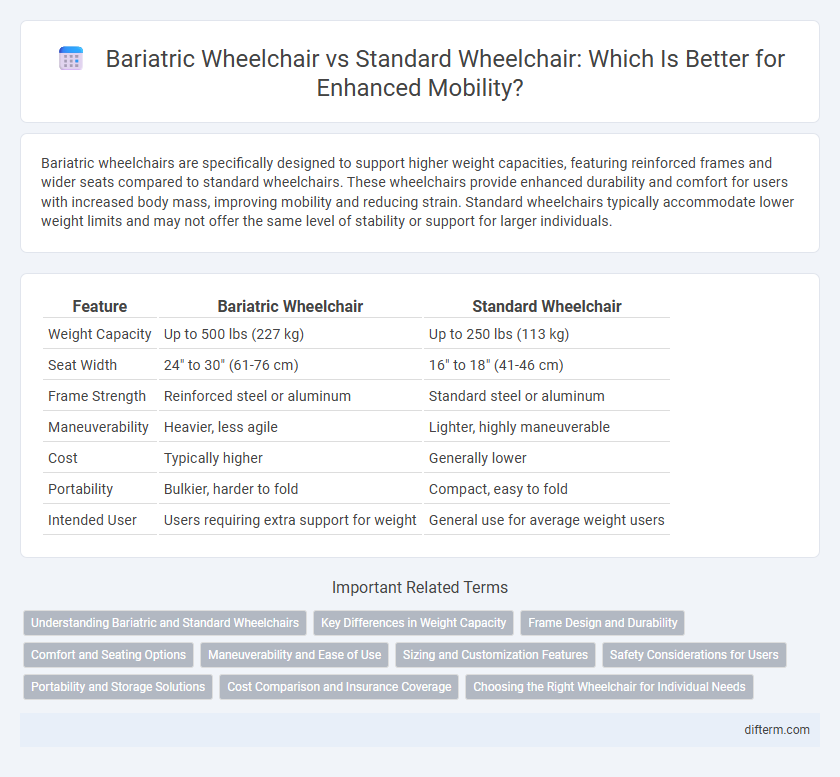Bariatric wheelchairs are specifically designed to support higher weight capacities, featuring reinforced frames and wider seats compared to standard wheelchairs. These wheelchairs provide enhanced durability and comfort for users with increased body mass, improving mobility and reducing strain. Standard wheelchairs typically accommodate lower weight limits and may not offer the same level of stability or support for larger individuals.
Table of Comparison
| Feature | Bariatric Wheelchair | Standard Wheelchair |
|---|---|---|
| Weight Capacity | Up to 500 lbs (227 kg) | Up to 250 lbs (113 kg) |
| Seat Width | 24" to 30" (61-76 cm) | 16" to 18" (41-46 cm) |
| Frame Strength | Reinforced steel or aluminum | Standard steel or aluminum |
| Maneuverability | Heavier, less agile | Lighter, highly maneuverable |
| Cost | Typically higher | Generally lower |
| Portability | Bulkier, harder to fold | Compact, easy to fold |
| Intended User | Users requiring extra support for weight | General use for average weight users |
Understanding Bariatric and Standard Wheelchairs
Bariatric wheelchairs are specifically designed to support higher weight capacities, typically ranging from 300 to 600 pounds, featuring reinforced frames, extra-wide seats, and durable materials to enhance comfort and safety for larger users. Standard wheelchairs generally accommodate weights up to 250 pounds and offer narrower seats and lighter, less robust construction suitable for everyday mobility needs. Understanding these differences ensures users select the appropriate wheelchair based on weight requirements, mobility comfort, and long-term durability.
Key Differences in Weight Capacity
Bariatric wheelchairs are specifically designed to support higher weight capacities, typically ranging from 350 to 600 pounds, compared to standard wheelchairs which generally accommodate up to 250 pounds. The enhanced frame strength and wider seat dimensions in bariatric wheelchairs provide improved durability and comfort for users with increased weight needs. This difference in weight capacity ensures safer, more reliable mobility solutions for individuals requiring extra support.
Frame Design and Durability
Bariatric wheelchairs feature reinforced steel or aluminum frames designed to support higher weight capacities, often exceeding 400 pounds, ensuring enhanced durability and structural integrity compared to standard wheelchairs. Standard wheelchairs typically utilize lighter frame materials like aluminum, prioritizing portability over heavy-duty strength, which may limit their lifespan under increased stress. The robust frame design of bariatric wheelchairs minimizes wear and tear, providing long-term stability essential for users requiring additional support.
Comfort and Seating Options
Bariatric wheelchairs feature reinforced frames and wider seats designed to support higher weight capacities, providing enhanced comfort for users requiring additional room. Specialized cushioning and pressure-relief seating options help prevent sores and improve overall positioning compared to standard wheelchairs. Adjustable armrests, backrests, and footrests further customize comfort, accommodating diverse body types and mobility needs.
Maneuverability and Ease of Use
Bariatric wheelchairs are designed with wider frames and reinforced wheels to support higher weight capacities, which can slightly reduce maneuverability compared to standard wheelchairs. Standard wheelchairs typically offer more agility and ease of use in tight spaces due to their lighter weight and narrower dimensions. Users requiring bariatric wheelchairs benefit from enhanced durability and comfort, though they may experience a trade-off in quick directional changes and portability.
Sizing and Customization Features
Bariatric wheelchairs offer wider seats and reinforced frames designed to support higher weight capacities, typically ranging from 300 to 600 pounds, compared to standard wheelchairs that usually accommodate up to 250 pounds. Customization features in bariatric models include adjustable seat widths, depths, and specialized cushioning to enhance comfort and prevent pressure sores. Standard wheelchairs provide fewer sizing options, often limiting customization to basic dimensions and minimal support accessories.
Safety Considerations for Users
Bariatric wheelchairs offer enhanced safety features such as reinforced frames, wider seats, and higher weight capacity, reducing the risk of frame failure or tipping compared to standard wheelchairs. These wheelchairs often include stronger brakes and anti-tip devices tailored for heavier users, promoting stability during movement. Ensuring proper fit and customized adjustments in bariatric models minimizes pressure sores and improves overall user safety during prolonged mobility.
Portability and Storage Solutions
Bariatric wheelchairs are specifically designed to support higher weight capacities, often resulting in a bulkier and heavier frame compared to standard wheelchairs, which can impact portability and storage ease. Standard wheelchairs typically feature foldable frames and lightweight materials, making them more suitable for compact storage and frequent transport. Advanced bariatric models are increasingly incorporating collapsible designs and innovative storage solutions to enhance portability without compromising durability and support.
Cost Comparison and Insurance Coverage
Bariatric wheelchairs typically cost between $1,200 and $3,500, significantly higher than standard wheelchairs, which range from $300 to $1,000 due to reinforced frames and wider seats. Insurance coverage for bariatric wheelchairs often requires documented medical necessity and prior authorization, as many providers have stricter criteria compared to standard wheelchairs that are more frequently approved. Patients should verify specific insurance policies to determine coverage limits, co-pays, and eligibility related to bariatric mobility aids to avoid unexpected out-of-pocket expenses.
Choosing the Right Wheelchair for Individual Needs
Selecting the right wheelchair depends on factors such as user weight, mobility range, and comfort requirements, where bariatric wheelchairs are designed to support higher weight capacities, typically over 300 pounds, with reinforced frames and wider seats. Standard wheelchairs offer more portability and lighter weight but may lack the durability and space needed for larger individuals. Understanding personal mobility needs, body dimensions, and lifestyle activities ensures optimal wheelchair choice for daily use and long-term health.
bariatric wheelchair vs standard wheelchair Infographic

 difterm.com
difterm.com